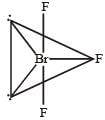Class 11 Exam > Class 11 Questions > In BrF3 molecule, the lone pairs occupy equat...
Start Learning for Free
In BrF3 molecule, the lone pairs occupy equatorial positions to minimize [2004]
- a)lone pair - bond pair repulsion only
- b)bond pair - bond pair repulsion only
- c)lone pair - lone pair repulsion and lone pair -bond pair repulsion
- d)lone pair - lone pair repulsion only
Correct answer is option 'C'. Can you explain this answer?
Verified Answer
In BrF3 molecule, the lone pairs occupy equatorial positions to minimi...

In BrF3, both bond pairs as well as lone pairs of electrons are present. Due to the presence of lone pairs of electrons (lp) in the valence shell, the bond angle is contracted and the molecule takes the T-shape. This is due to greater repulsion between two lone pairs or between a lone pair and a bond pair than between the two bond pairs.
Most Upvoted Answer
In BrF3 molecule, the lone pairs occupy equatorial positions to minimi...
Explanation:
The BrF3 molecule has a trigonal bipyramidal shape with three equatorial fluorine atoms and two axial fluorine atoms. The two lone pairs of electrons on the central Br atom occupy the two axial positions, while the three bond pairs occupy the three equatorial positions. This arrangement is preferred to minimize the repulsion between the lone pairs and the bond pairs, as well as between the lone pairs themselves.
Lone pair - lone pair repulsion:
The lone pairs of electrons on the central Br atom experience repulsion from each other. This is because the electrons in the lone pairs are negatively charged and they repel each other due to their like charges. This repulsion is greater than the repulsion between the lone pairs and the bond pairs. Therefore, the two lone pairs occupy the two axial positions to minimize their repulsion with each other.
Lone pair - bond pair repulsion:
The lone pairs of electrons on the central Br atom also experience repulsion from the bond pairs of electrons. This is because the electrons in the bond pairs are also negatively charged and they repel the electrons in the lone pairs. The repulsion between the lone pairs and the bond pairs is less than the repulsion between the lone pairs themselves. Therefore, the three bond pairs occupy the three equatorial positions to minimize their repulsion with the lone pairs.
Lone pair - lone pair repulsion and lone pair - bond pair repulsion:
The BrF3 molecule has both lone pairs and bond pairs of electrons. The repulsion between the lone pairs and the bond pairs, as well as between the lone pairs themselves, must be minimized to achieve the most stable arrangement. Therefore, the two lone pairs occupy the two axial positions, and the three bond pairs occupy the three equatorial positions. This arrangement minimizes both the lone pair - bond pair repulsion and the lone pair - lone pair repulsion, making the BrF3 molecule more stable.
The BrF3 molecule has a trigonal bipyramidal shape with three equatorial fluorine atoms and two axial fluorine atoms. The two lone pairs of electrons on the central Br atom occupy the two axial positions, while the three bond pairs occupy the three equatorial positions. This arrangement is preferred to minimize the repulsion between the lone pairs and the bond pairs, as well as between the lone pairs themselves.
Lone pair - lone pair repulsion:
The lone pairs of electrons on the central Br atom experience repulsion from each other. This is because the electrons in the lone pairs are negatively charged and they repel each other due to their like charges. This repulsion is greater than the repulsion between the lone pairs and the bond pairs. Therefore, the two lone pairs occupy the two axial positions to minimize their repulsion with each other.
Lone pair - bond pair repulsion:
The lone pairs of electrons on the central Br atom also experience repulsion from the bond pairs of electrons. This is because the electrons in the bond pairs are also negatively charged and they repel the electrons in the lone pairs. The repulsion between the lone pairs and the bond pairs is less than the repulsion between the lone pairs themselves. Therefore, the three bond pairs occupy the three equatorial positions to minimize their repulsion with the lone pairs.
Lone pair - lone pair repulsion and lone pair - bond pair repulsion:
The BrF3 molecule has both lone pairs and bond pairs of electrons. The repulsion between the lone pairs and the bond pairs, as well as between the lone pairs themselves, must be minimized to achieve the most stable arrangement. Therefore, the two lone pairs occupy the two axial positions, and the three bond pairs occupy the three equatorial positions. This arrangement minimizes both the lone pair - bond pair repulsion and the lone pair - lone pair repulsion, making the BrF3 molecule more stable.
Free Test
| FREE | Start Free Test |
Community Answer
In BrF3 molecule, the lone pairs occupy equatorial positions to minimi...

In BrF3, both bond pairs as well as lone pairs of electrons are present. Due to the presence of lone pairs of electrons (lp) in the valence shell, the bond angle is contracted and the molecule takes the T-shape. This is due to greater repulsion between two lone pairs or between a lone pair and a bond pair than between the two bond pairs.

|
Explore Courses for Class 11 exam
|

|
Question Description
In BrF3 molecule, the lone pairs occupy equatorial positions to minimize [2004]a)lone pair - bond pair repulsion onlyb)bond pair - bond pair repulsion onlyc)lone pair - lone pair repulsion and lone pair -bond pair repulsiond)lone pair - lone pair repulsion onlyCorrect answer is option 'C'. Can you explain this answer? for Class 11 2025 is part of Class 11 preparation. The Question and answers have been prepared according to the Class 11 exam syllabus. Information about In BrF3 molecule, the lone pairs occupy equatorial positions to minimize [2004]a)lone pair - bond pair repulsion onlyb)bond pair - bond pair repulsion onlyc)lone pair - lone pair repulsion and lone pair -bond pair repulsiond)lone pair - lone pair repulsion onlyCorrect answer is option 'C'. Can you explain this answer? covers all topics & solutions for Class 11 2025 Exam. Find important definitions, questions, meanings, examples, exercises and tests below for In BrF3 molecule, the lone pairs occupy equatorial positions to minimize [2004]a)lone pair - bond pair repulsion onlyb)bond pair - bond pair repulsion onlyc)lone pair - lone pair repulsion and lone pair -bond pair repulsiond)lone pair - lone pair repulsion onlyCorrect answer is option 'C'. Can you explain this answer?.
In BrF3 molecule, the lone pairs occupy equatorial positions to minimize [2004]a)lone pair - bond pair repulsion onlyb)bond pair - bond pair repulsion onlyc)lone pair - lone pair repulsion and lone pair -bond pair repulsiond)lone pair - lone pair repulsion onlyCorrect answer is option 'C'. Can you explain this answer? for Class 11 2025 is part of Class 11 preparation. The Question and answers have been prepared according to the Class 11 exam syllabus. Information about In BrF3 molecule, the lone pairs occupy equatorial positions to minimize [2004]a)lone pair - bond pair repulsion onlyb)bond pair - bond pair repulsion onlyc)lone pair - lone pair repulsion and lone pair -bond pair repulsiond)lone pair - lone pair repulsion onlyCorrect answer is option 'C'. Can you explain this answer? covers all topics & solutions for Class 11 2025 Exam. Find important definitions, questions, meanings, examples, exercises and tests below for In BrF3 molecule, the lone pairs occupy equatorial positions to minimize [2004]a)lone pair - bond pair repulsion onlyb)bond pair - bond pair repulsion onlyc)lone pair - lone pair repulsion and lone pair -bond pair repulsiond)lone pair - lone pair repulsion onlyCorrect answer is option 'C'. Can you explain this answer?.
Solutions for In BrF3 molecule, the lone pairs occupy equatorial positions to minimize [2004]a)lone pair - bond pair repulsion onlyb)bond pair - bond pair repulsion onlyc)lone pair - lone pair repulsion and lone pair -bond pair repulsiond)lone pair - lone pair repulsion onlyCorrect answer is option 'C'. Can you explain this answer? in English & in Hindi are available as part of our courses for Class 11.
Download more important topics, notes, lectures and mock test series for Class 11 Exam by signing up for free.
Here you can find the meaning of In BrF3 molecule, the lone pairs occupy equatorial positions to minimize [2004]a)lone pair - bond pair repulsion onlyb)bond pair - bond pair repulsion onlyc)lone pair - lone pair repulsion and lone pair -bond pair repulsiond)lone pair - lone pair repulsion onlyCorrect answer is option 'C'. Can you explain this answer? defined & explained in the simplest way possible. Besides giving the explanation of
In BrF3 molecule, the lone pairs occupy equatorial positions to minimize [2004]a)lone pair - bond pair repulsion onlyb)bond pair - bond pair repulsion onlyc)lone pair - lone pair repulsion and lone pair -bond pair repulsiond)lone pair - lone pair repulsion onlyCorrect answer is option 'C'. Can you explain this answer?, a detailed solution for In BrF3 molecule, the lone pairs occupy equatorial positions to minimize [2004]a)lone pair - bond pair repulsion onlyb)bond pair - bond pair repulsion onlyc)lone pair - lone pair repulsion and lone pair -bond pair repulsiond)lone pair - lone pair repulsion onlyCorrect answer is option 'C'. Can you explain this answer? has been provided alongside types of In BrF3 molecule, the lone pairs occupy equatorial positions to minimize [2004]a)lone pair - bond pair repulsion onlyb)bond pair - bond pair repulsion onlyc)lone pair - lone pair repulsion and lone pair -bond pair repulsiond)lone pair - lone pair repulsion onlyCorrect answer is option 'C'. Can you explain this answer? theory, EduRev gives you an
ample number of questions to practice In BrF3 molecule, the lone pairs occupy equatorial positions to minimize [2004]a)lone pair - bond pair repulsion onlyb)bond pair - bond pair repulsion onlyc)lone pair - lone pair repulsion and lone pair -bond pair repulsiond)lone pair - lone pair repulsion onlyCorrect answer is option 'C'. Can you explain this answer? tests, examples and also practice Class 11 tests.

|
Explore Courses for Class 11 exam
|

|
Signup for Free!
Signup to see your scores go up within 7 days! Learn & Practice with 1000+ FREE Notes, Videos & Tests.


















